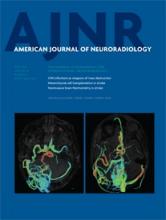Review ArticleReview Articles
Open Access
4D-CTA in Neurovascular Disease: A Review
H.G.J. Kortman, E.J. Smit, M.T.H. Oei, R. Manniesing, M. Prokop and F.J.A. Meijer
American Journal of Neuroradiology June 2015, 36 (6) 1026-1033; DOI: https://doi.org/10.3174/ajnr.A4162
H.G.J. Kortman
aFrom the Department of Radiology and Nuclear Medicine, Radboud University Nijmegen Medical Center, Nijmegen, the Netherlands.
E.J. Smit
aFrom the Department of Radiology and Nuclear Medicine, Radboud University Nijmegen Medical Center, Nijmegen, the Netherlands.
M.T.H. Oei
aFrom the Department of Radiology and Nuclear Medicine, Radboud University Nijmegen Medical Center, Nijmegen, the Netherlands.
R. Manniesing
aFrom the Department of Radiology and Nuclear Medicine, Radboud University Nijmegen Medical Center, Nijmegen, the Netherlands.
M. Prokop
aFrom the Department of Radiology and Nuclear Medicine, Radboud University Nijmegen Medical Center, Nijmegen, the Netherlands.
F.J.A. Meijer
aFrom the Department of Radiology and Nuclear Medicine, Radboud University Nijmegen Medical Center, Nijmegen, the Netherlands.

References
- 1.↵
- Klingebiel R,
- Siebert E,
- Diekmann S, et al
- 2.↵
- 3.↵
- Alexander MD,
- Oliff MC,
- Olorunsola OG, et al
- 4.↵
- James RF,
- Wainwright KJ,
- Kanaan HA, et al
- 5.↵
- Willinsky RA,
- Taylor SM,
- terBrugge K, et al
- 6.↵
- Cloft HJ,
- Joseph GJ,
- Dion JE
- 7.↵
- Kaufmann TJ,
- Huston J,
- Mandrekar JN, et al
- 8.↵
- Bendszus M,
- Koltzenburg M,
- Burger R, et al
- 9.↵
- Morhard D,
- Wirth CD,
- Fesl G, et al
- 10.↵
- Hoogenboom TC,
- van Beurden RM,
- van Teylingen B, et al
- 11.↵
- Roberts HC,
- Roberts TP,
- Smith WS, et al
- 12.↵
- 13.↵
- Saake M,
- Goelitz P,
- Struffert T, et al
- 14.↵
- Yang CY,
- Chen YF,
- Lee CW, et al
- 15.↵
- 16.↵
- 17.↵
- Lin CJ,
- Wu TH,
- Lin CH, et al
- 18.↵
- Manninen AL,
- Isokangas JM,
- Karttunen A, et al
- 19.↵
- Siebert E,
- Bohner G,
- Dewey M, et al
- 20.↵
- Moskowitz SI,
- Davros WJ,
- Kelly ME, et al
- 21.↵
- Vano E,
- Fernandez JM,
- Sanchez RM, et al
- 22.↵
- Smit EJ,
- Vonken EJ,
- van Seeters T, et al
- 23.↵
- Spetzler RF,
- Martin NA
- 24.↵
- Cognard C,
- Gobin YP,
- Pierot L, et al
- 25.↵
- Borden JA,
- Wu JK,
- Shucart WA
- 26.↵
- 27.↵
- Willems PW,
- Taeshineetanakul P,
- Schenk B, et al
- 28.↵
- 29.↵
- 30.↵
- Brouwer PA,
- Bosman T,
- van Walderveen MA, et al
- 31.↵
- 32.↵
- Willems PW,
- Brouwer PA,
- Barfett JJ, et al
- 33.↵
- 34.↵
- 35.↵
- 36.↵
- Becker KJ,
- Baxter AB,
- Bybee HM, et al
- 37.↵
- 38.↵
- 39.↵
- Riedel CH,
- Zimmermann P,
- Jensen-Kondering U, et al
- 40.↵
- Frölich AM,
- Schrader D,
- Klotz E, et al
- 41.↵
- 42.↵
- Suarez JI,
- Sunshine JL,
- Tarr R, et al
- 43.↵
- Christoforidis GA,
- Mohammad Y,
- Avutu B, et al
- 44.↵
- Frölich AM,
- Psychogios MN,
- Klotz E, et al
- 45.↵
- Ringelstein EB,
- Biniek R,
- Weiller C, et al
- 46.↵
- McVerry F,
- Liebeskind DS,
- Muir KW
- 47.↵
- Miteff F,
- Levi CR,
- Bateman GA, et al
- 48.↵
- Kucinski T,
- Koch C,
- Eckert B, et al
- 49.↵
- Maas MB,
- Lev MH,
- Ay H, et al
- 50.↵
- Souza LC,
- Yoo AJ,
- Chaudhry ZA, et al
- 51.↵
- Tan IY,
- Demchuk AM,
- Hopyan J, et al
- 52.↵
- 53.↵
- 54.↵
- Oei M,
- Manniesing R,
- Meijer FJ, et al
In this issue
American Journal of Neuroradiology
Vol. 36, Issue 6
1 Jun 2015
Advertisement
H.G.J. Kortman, E.J. Smit, M.T.H. Oei, R. Manniesing, M. Prokop, F.J.A. Meijer
4D-CTA in Neurovascular Disease: A Review
American Journal of Neuroradiology Jun 2015, 36 (6) 1026-1033; DOI: 10.3174/ajnr.A4162
0 Responses
Jump to section
Related Articles
Cited By...
- Management of a wake-up stroke
- Color-Mapping of 4D-CTA for the Detection of Cranial Arteriovenous Shunts
- Diagnostic accuracy of emergency CT angiography for presumed tandem internal carotid artery occlusion before acute endovascular therapy
- Improved Detection of Anterior Circulation Occlusions: The "Delayed Vessel Sign" on Multiphase CT Angiography
- Republished: Remote multifocal bleeding points producing a Sylvian subpial hematoma during endovascular coiling of an acutely ruptured cerebral aneurysm
- Remote multifocal bleeding points producing a Sylvian subpial hematoma during endovascular coiling of an acutely ruptured cerebral aneurysm
- Time-Resolved C-Arm Computed Tomographic Angiography Derived From Computed Tomographic Perfusion Acquisition: New Capability for One-Stop-Shop Acute Ischemic Stroke Treatment in the Angiosuite
This article has not yet been cited by articles in journals that are participating in Crossref Cited-by Linking.
More in this TOC Section
Similar Articles
Advertisement











